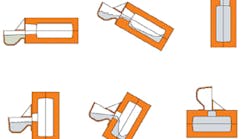Aluminum permanent mold casting, or gravity die-casting, is the casting of molten aluminum in a reusable metal mold or die. The die material is most commonly cast iron or steel. Tiltpouring is one variation of the permanent mold process.
Simply put, the tilt-pour casting process is the pouring of molten aluminum into a mold by tilting the mold to fill it in a controlled fashion. In traditional tilt-pouring the mold parting line is perpendicular to the floor during the solidification phase, while in reverse tilting the parting line is parallel to the floor. Turning the parting line allows the casting to be center-fed similar to the way a casting is produced in the low-pressure process. This feature makes reverse tilting a cost-effective alternative to capital-intensive lowpressure casting. In many cases the casting can be direct poured, eliminating costly runner bars and increasing yield.
The cost of a reverse-tilting work cell is the same as it is to set up a traditional tilt-pouring cell, with the casting machine, hydraulic power unit, and controls being under $75,000. The mold cost varies with the geometry and complexity of the finished casting, but in most cases the mold will cost $15,000- $50,000. In most foundries, existing peripheral equipment such as furnaces and saws can be used. Compared to the $500,000 investment in a low-pressure casting cell, this is an attractive option.
The productivity of a single machine cell is the same as the productivity of the low-pressure process, 12-30 cycles per hour. If the casting machines are placed on an indexing rotary table, the productivity rate for a casting with a five minute cycle time is 120 cycles per hour. When coupled with multi-axis tending robots, this productivity can be achieved with one operator. In most cases one can expect 95% uptime and scrap rates equal to other casting processes.
The reverse-tilting process is ideally suited for radial type castings, such as wheels, hubs, compressor housings, automotive structural castings, and cookware, but the process is not limited to radial casting and has been used to cast high-performance brake calipers. Other value-added features can be used, such as cast-in steel inserts or sand cores, as in the semi-permanent mold process.
Dies can be as varied as the castings themselves and the only limit is the tool designer’s imagination. A variety of chilling systems can be added to promote directional solidification. These include metal inserts, and air- and water- cooling circuits. Currently there are four sizes of reverse-tilting casting machines available with die sizes ranging from 2020 to 2448 in.
Reverse tilting can offer the casting designer and tooling designer another alternative in casting and tool design. It will offer the foundry a production process that is cost effective and profitable.
John Hall is the president of CMH Manufacturing.









